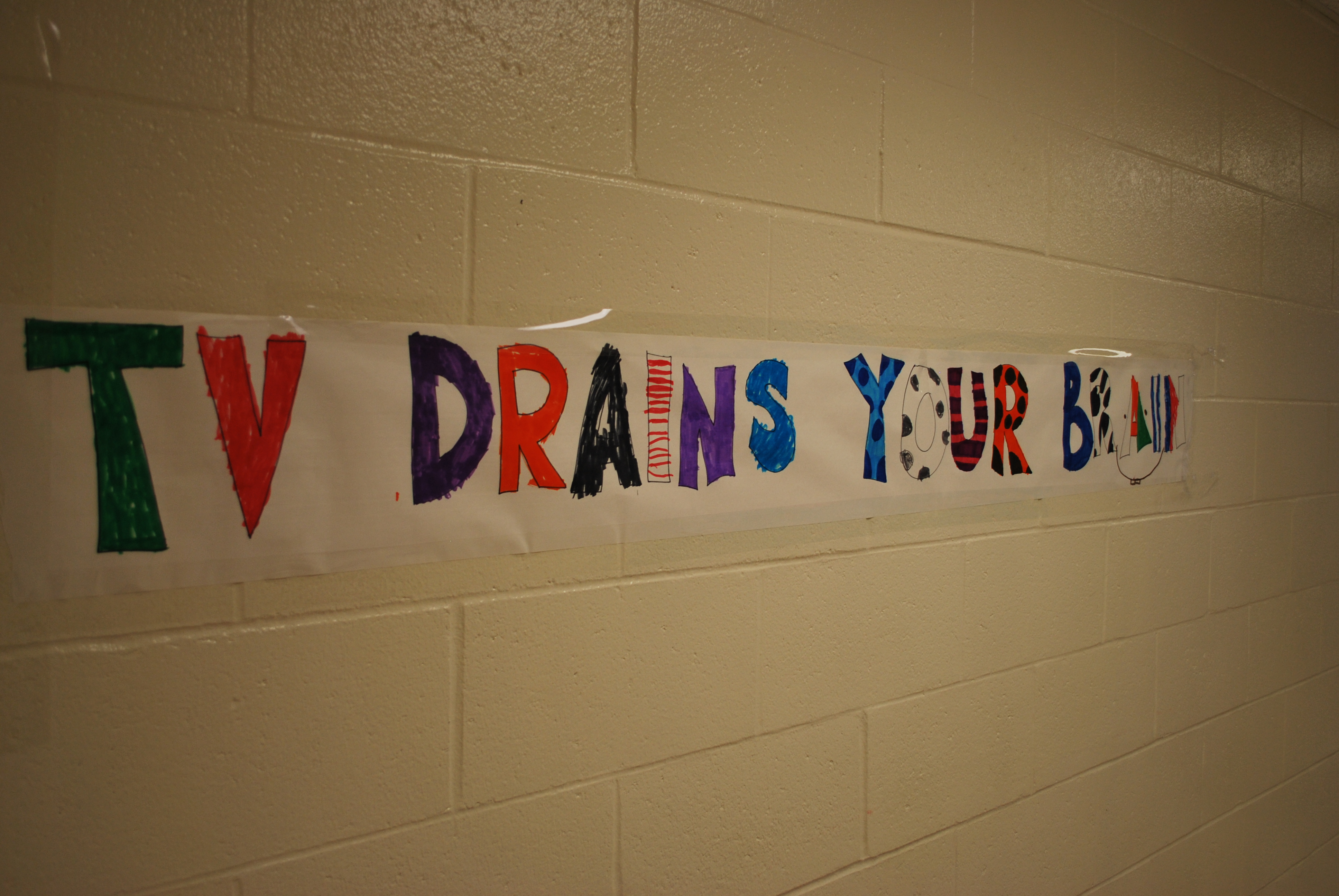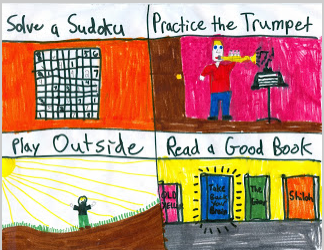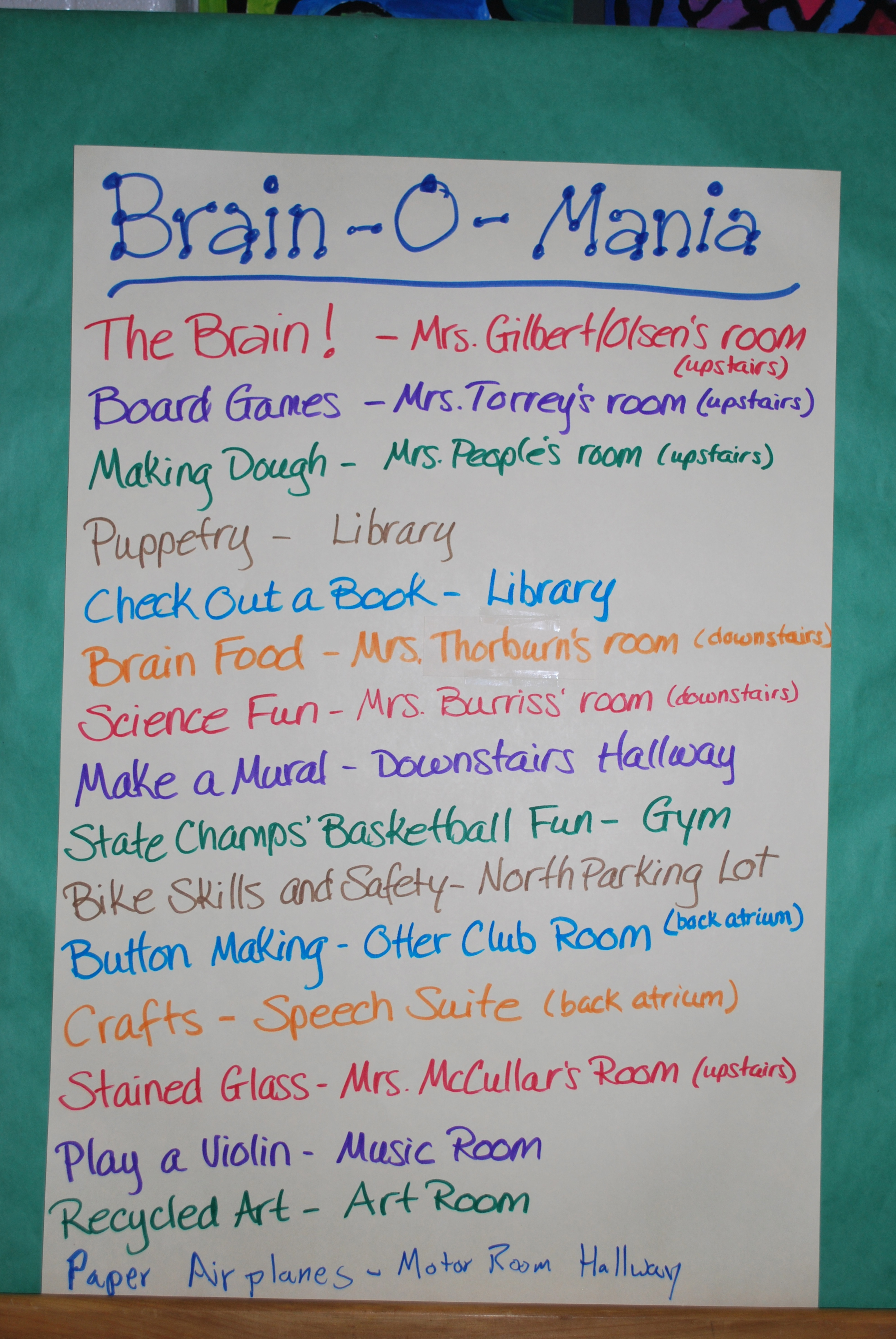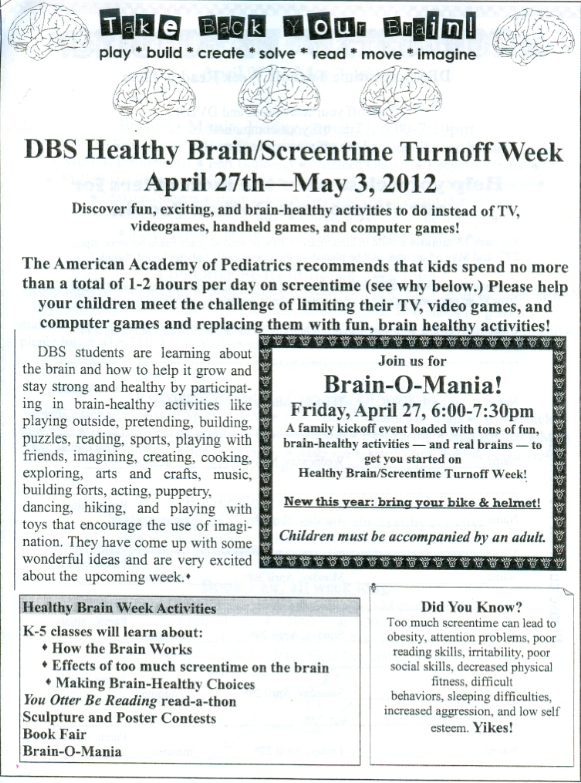 This is my busiest time of the year! (Which might help to explain the lapse in blogging.) Classes, groups, and individual counseling are full steam ahead; we are deeply into the application and interview process for hiring multiple new teachers; kindergarten screening and middle school transition are looming; lots of kids are really struggling; and next week is our Healthy Brain/Screen Time Turnoff Week.
This is my busiest time of the year! (Which might help to explain the lapse in blogging.) Classes, groups, and individual counseling are full steam ahead; we are deeply into the application and interview process for hiring multiple new teachers; kindergarten screening and middle school transition are looming; lots of kids are really struggling; and next week is our Healthy Brain/Screen Time Turnoff Week.
Ten years ago, our teachers began noticing some significant changes in kids’ ability to focus and persevere on their work. We were also noticing kids talking much more about spending their time on video games and watching TV instead of playing. Some kids didn’t seem to know how to engage in imaginative play unless they used a “script” from a cartoon or movie. Many were doing much less reading at home. Thus was born Healthy Brain/Screen Time Turnoff Week.
 The goal of Healthy Brain/Screen Time Turnoff Week is to build awareness among kids and parents about how too much screen time can negatively impact learning and health. In the month leading up to the big week, my co-counselor and I teach a neuroscience unit (no kidding!) in all classes. They learn about what the brain does (grades K-5), the structures of the brain (grades 1-5), how neural pathways are built and how neurotransmission works (grades 2-5), how addictions (to drugs, alcohol, and video games) develop (grades 4-5), the effect of drugs and alcohol on the brain (grade 5), and specific health and learning effects of too much screen time (grades 3-5). I think you’d be impressed to hear how much the kids know about neuroscience! The kids also identify fun and engaging activities that encourage movement, problem-solving, imagination, creativity, and reading so that they are better able to replace some of their screen time with brain-healthy activities.
The goal of Healthy Brain/Screen Time Turnoff Week is to build awareness among kids and parents about how too much screen time can negatively impact learning and health. In the month leading up to the big week, my co-counselor and I teach a neuroscience unit (no kidding!) in all classes. They learn about what the brain does (grades K-5), the structures of the brain (grades 1-5), how neural pathways are built and how neurotransmission works (grades 2-5), how addictions (to drugs, alcohol, and video games) develop (grades 4-5), the effect of drugs and alcohol on the brain (grade 5), and specific health and learning effects of too much screen time (grades 3-5). I think you’d be impressed to hear how much the kids know about neuroscience! The kids also identify fun and engaging activities that encourage movement, problem-solving, imagination, creativity, and reading so that they are better able to replace some of their screen time with brain-healthy activities.
 To kick off the week we hold a school-wide Healthy Brain assembly. Fourth and fifth graders put on skits about the effects of screentime and how to keep your brain healthy, and the second graders sing “Take Back Your Brain!” (which easily gets stuck in your brain, believe me!). Bulletin boards and walls get covered with brain-related posters and projects in preparation for our school’s biggest night of the year: Brain-O-Mania, an evening family event. The highlight of the evening is always the Brain Room, which features real human and animal brains that kids can look at, touch, or hold.
To kick off the week we hold a school-wide Healthy Brain assembly. Fourth and fifth graders put on skits about the effects of screentime and how to keep your brain healthy, and the second graders sing “Take Back Your Brain!” (which easily gets stuck in your brain, believe me!). Bulletin boards and walls get covered with brain-related posters and projects in preparation for our school’s biggest night of the year: Brain-O-Mania, an evening family event. The highlight of the evening is always the Brain Room, which features real human and animal brains that kids can look at, touch, or hold.
 There are brain-related activities (brain puzzles, coloring pages, neuron-building), brain jello to eat, and a brain quiz that encourages families to learn more about screen time and the brain (you have to take the quiz in order to be entered into the raffle for fabulous and fun brain-healthy prizes!) The rest of the school is filled with stations featuring activities to do instead of screen time. We change up what we offer every year, but there are always movement, arts and crafts, building, creative, pretend, cooperative, and literacy activities. (You can see this year’s activities below. Other year’s favorites have included paper airplanes and origami, fairy houses, cartooning, mini golf, make your own board game, hip-hop, mural making, and puppetry.)
There are brain-related activities (brain puzzles, coloring pages, neuron-building), brain jello to eat, and a brain quiz that encourages families to learn more about screen time and the brain (you have to take the quiz in order to be entered into the raffle for fabulous and fun brain-healthy prizes!) The rest of the school is filled with stations featuring activities to do instead of screen time. We change up what we offer every year, but there are always movement, arts and crafts, building, creative, pretend, cooperative, and literacy activities. (You can see this year’s activities below. Other year’s favorites have included paper airplanes and origami, fairy houses, cartooning, mini golf, make your own board game, hip-hop, mural making, and puppetry.)
During the week, we encourage families to turn off their screens (work-related screen time doesn’t count), limit screen time to the recommended maximum of no more than a total of two hours per day, or cut back even just a little bit. We hold a recycled sculpture contest and a poster contest, a book fair (all students are able to get books, regardless of their ability to pay), and a read-a-thon. Each day in the classroom students share what they did the day before instead of screen time. Some classes write about the brain and screen time. Some use data they gather about their activities to graph and do other math activities.
Healthy Brain/Screen Time Turnoff Week (which is really more like Healthy Brain Month, once you add in all the preparations and lessons) has been successful beyond my wildest dreams. It is probably one of the things I’ve done professionally that I’m most proud of. The kids LOVE learning about their brains, and I definitely think we have raised awareness about the issue of too much screen time. The energy from kids and staff is palpable, and gets bigger and better every year. (New this year — but I think it’s going to go viral — one of our teachers knitted a brain hat! The kids went wild for it, and it will be a hot prize item at Brain-O-Mania. I am hoping to wear it when I emcee the assembly tomorrow. I will try to get a picture of it, because you just have to see it to believe it.) The kids talk about the brain and Brain-O-Mania all year long, and excitedly explain all about it to new students. And because the kids already have an understanding of how the brain works, we can discuss the brain in relation to feelings, bullying, conflict resolution, behavior, and substance abuse in our class council lessons on these topics. The fifth graders talked about the potential effects of child abuse on the brain (the hippocampus and amygdala, specifically) a few weeks ago. (More on this to come.)
I am usually pretty exhausted once all of this is over and really need to Take Back My Brain! But it’s a good exhausted! I’ll be glad to post links to some great resources if anyone else is interested in teaching about the brain. It is so worth it! And so much fun!
Here is some of the info we sent home to parents. Sorry for the quality. My computer is having technical difficulties. And my brain is too, after trying in vain to straighten them out!




OK, this is a GENIUS idea . . . and I want a picture of you in that hand-knit brain hat. The brain is SO interesting and I’ll just bet your kid are eating it up! What a fun night you have planned . . . thanks for planting a seed!!